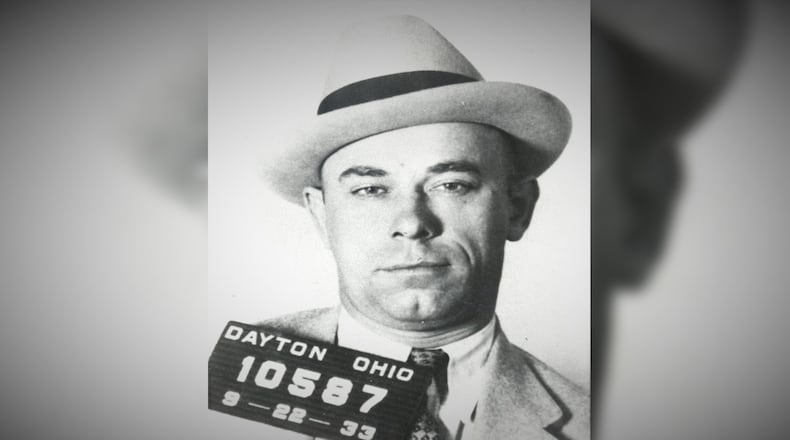Approximately $50,000 was said to be stolen during the robberies.
In Dayton for a reason
Mary Longnecker, 23, the sister of one of Dillinger’s fellow Indiana inmates, was living in Dayton.
Enticed by the stories his prison pal told, Dillinger traveled to Dayton, eager to meet Longnecker.
A romance developed, and Dillinger visited Longnecker at her boarding house at West First Street over the summer months.
Agents with the Pinkerton National Detective Agency learned about the robber’s romance, and with cooperation from the boarding house landlord, Lucille Stricker, and Dayton police, a plan was made to catch Dillinger.
The arrest
The raid on the house where Dillinger was staying was led by chief detective S. E. Yendes.
The landlord alerted police that Dillinger was at the boarding house and they quickly arrived and knocked on the door. Police burst into the room after Longnecker opened the door.
Dillinger didn’t attempt to use the .45 automatic in his pocket or the smaller pistol hidden up his sleeve. The Dayton Daily News reported that Dillinger later told police “I would have been a … fool to have pulled that gun.”
Dayton police detective Russell Pfauhl, who made the arrest, said in a 1973 Dayton Daily News interview: “I said to him, ‘John, police officers. Stick them up and face the wall.’ He put his hands up to the level of his shoulders and then dropped them again. I said to him, ’I’ll kill you if you don’t put them up.”
Dillinger was guarded by officers armed with rifles and shotguns following his 1 a.m. arrest. Dillinger was the leader of a group of bandits, and the police were worried his accomplices might try to free him.
Four pistols, $2,600 in cash, quantities of rifle and shotgun shells, detailed notes explaining the quickest ways to escape from various cities, and sacks full of carpet tacks were found in his room. Police said the tacks were to be scattered over roads to puncture tires of cars in pursuit.
Dillinger said that he didn’t believe they were really police, but members of a rival gang trying to pull something. Later, under questioning, Dillinger, calm and smiling, said, “See my lawyer.”
Dillinger’s Colt .38 Super semiautomatic gun became a bit of a trophy and was engraved with the words “Taken from the Fugitive John Dillinger upon arrest by Dayton Police.”
The notorious bank robber’s gun remained in Dayton Police Chief Rudolph Wurstner’s possession until after his death. He had carried the gun until 1949.
In 2004, the gun was donated to Carillon Historical Park. The gun, the handcuffs that were placed on him, bank teller windows from several Greater Dayton banks that the Dillinger gang robbed in 1933 and far more, are currently on display in an exhibit titled, “Bootleggers, Bandits, and Badges: From Dry Times in Dayton, Ohio.” The exhibit is scheduled to close in just three months at the end of 2023 after a 50-month run.
The aftermath
Several jurisdictions in three states were “fighting for possession of John Dillinger.”
Montgomery County Common Pleas Judge Robert C. Patterson turned Dillinger over to armed guards, who escorted the gangster to the jail in Lima, to await trial in Allen County for robbing the Citizens National Bank in Bluffton.
Dillinger’s gang escaped from their Indiana prison and made their way to Lima. They passed themselves off as prison officials and broke Dillinger out of jail, killing Sheriff Jesse Sarber during the escape.
Between September 1933 and July 1934, the FBI says Dillinger and his gang killed 10 men, wounded seven others, robbed police arsenals and about a dozen banks (his first bank heist was of $10,600 from National Bank in New Carlisle on June 10, 1933).
Credit: file art
Credit: file art
Dillinger became “Public Enemy No. 1″ on the FBI’s most wanted list.
The gangster died in a hail of bullets outside the Biograph theater in Chicago on July 22, 1934. It was a month after his 31st birthday.
About the Author







